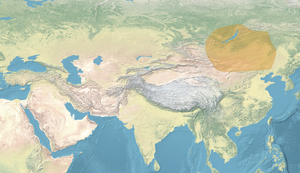
Back Култура на плочестите гробове Bulgarian Cultura de les tombes de llosa Catalan Plattengrabkultur German Cultura de las tumbas de losa Spanish ქვის ფილების საფლავების კულტურა Georgian 판석묘 문화 Korean Дөрвөлжин булш Mongolian Plaatgrafcultuur Dutch Hellegravkulturen NB Культура плиточных могил Russian
| Geographical range | Mongolia |
|---|---|
| Period | Bronze Age, Iron Age |
| Dates | 1300 (Transbaikal) 700 (Mongolia) –300 BC.[1] |
| Preceded by | Ulaanzuukh culture, Deer stones culture |
| Followed by | Xiongnu Empire |


The Slab-grave culture is an archaeological culture of Late Bronze Age and Early Iron Age Mongolia.[3][4] The Slab-Grave culture formed one of the primary ancestral components of the succeeding Xiongnu, as revealed by genetic evidence. The ethnogenesis of Turkic peoples and the modern Mongolian people is, at least partially, linked to the Slab-Grave culture by historical and archaeological evidence [5][6] and further corroborated by genetic research on the Slab Grave remains.[7][8]
The Slab-grave culture is dated from 1300 (Transbaikal) 700 (Mongolia) to 300 BC.[9] The origin of the Slab-grave culture is not definitively known, however genetic evidence is consistent with multiple hypotheses of a local origin dating back to at least the Bronze Age.[10] In particular, the people of the Ulaanzuukh culture and the Slab Grave culture are closely linked to the westwards expansion of Neolithic Amur ancestry associated with Ancient Northeast Asians (ANA).[11] The genetic profiles of individuals from the Ulaanzuukh LBA and the Slab Grave culture are identical, which is in agreement with the archaeological hypothesis that the Slab Grave culture emerged from the Ulaanzuukh.[12]
To the west and northwest, the Slab-Grave culture was adjacent to, and essentially contemporaneous with the Deer stones culture of primarily Khövsgöl LBA ancestry, and various Saka cultures such as the Tagar culture, the Pazyryk culture and the Aldy-Bel culture for a period of several centuries.[2][13] The Slab-Grave culture was superseded by the Xiongnu culture, which formed a vast empire stretching across much of the Eurasian world, and saw the hybridization of Scytho-Siberian and Eastern Steppe populations and cultures.
- ^ Fitzhugh 2009b, p. 80, In Mongolia square burials begin almost exactly when the use of deer stones and khirigsuurs ceases, about cal. 2700 B.P., and continue well into the Scythian period (Honeychurch, personal communication 2008)..
- ^ a b Gantulga, Jamiyan-Ombo (21 November 2020). "Ties between steppe and peninsula: Comparative perspective of the Bronze and Early Iron Ages of Мongolia and Кorea". Proceedings of the Mongolian Academy of Sciences: 65–88. doi:10.5564/pmas.v60i4.1507. ISSN 2312-2994. S2CID 234540665.
- ^ Н.Наваан, Дорнод Монголын хүрлийн үе (Mongolian), N.Navaan, Bronze Age of Eastern Mongolia
- ^ Tumen D., "Anthropology of Archaeological Populations from Northeast Asia [1] page 25,27
- ^ Vidaković, Nenad (30 April 2012). "From the Ethnic History of Asia – the Dōnghú, Wūhuán and Xiānbēi Proto-Mongolian Tribes". Migracijske i etničke teme (in Croatian). 28 (1): 75–95. ISSN 1333-2546. "Other types of sources on the history of the Proto-Mongolian tribes are archaeological findings, which associate Mongolian ethnogenesis with slab grave cultures and the Lower Xiàjiādiàn."
- ^ Savelyev, Alexander; Jeong, Choongwon (7 May 2020). "Early nomads of the Eastern Steppe and their tentative connections in the West". Evolutionary Human Sciences. 2: E20. doi:10.1017/ehs.2020.18. ISSN 2513-843X. PMC 7612788. PMID 35663512.
- ^ Jeong, Choongwon; Wang, Ke; Wilkin, Shevan; Taylor, William Timothy Treal; Miller, Bryan K.; Bemmann, Jan H.; Stahl, Raphaela; Chiovelli, Chelsea; Knolle, Florian; Ulziibayar, Sodnom; Khatanbaatar, Dorjpurev; Erdenebaatar, Diimaajav; Erdenebat, Ulambayar; Ochir, Ayudai; Ankhsanaa, Ganbold; Vanchigdash, Chuluunkhuu; Ochir, Battuga; Munkhbayar, Chuluunbat; Tumen, Dashzeveg; Kovalev, Alexey; Kradin, Nikolay; Bazarov, Bilikto A.; Miyagashev, Denis A.; Konovalov, Prokopiy B.; Zhambaltarova, Elena; Miller, Alicia Ventresca; Haak, Wolfgang; Schiffels, Stephan; Krause, Johannes; Boivin, Nicole; Erdene, Myagmar; Hendy, Jessica; Warinner, Christina (12 November 2020). "A Dynamic 6,000-Year Genetic History of Eurasia's Eastern Steppe". Cell. 183 (4): 890–904.e29. doi:10.1016/j.cell.2020.10.015. ISSN 1097-4172. PMC 7664836. PMID 33157037.
- ^ Jeong, Choongwon; Wang, Ke; Wilkin, Shevan; Taylor, William Timothy Treal; Miller, Bryan K.; Bemmann, Jan H.; Stahl, Raphaela; Chiovelli, Chelsea; Knolle, Florian; Ulziibayar, Sodnom; Khatanbaatar, Dorjpurev; Erdenebaatar, Diimaajav; Erdenebat, Ulambayar; Ochir, Ayudai; Ankhsanaa, Ganbold (November 2020). "A Dynamic 6,000-Year Genetic History of Eurasia's Eastern Steppe". Cell. 183 (4): 890–904.e29. doi:10.1016/j.cell.2020.10.015. ISSN 0092-8674. PMC 7664836. PMID 33157037.
- ^ Fitzhugh 2009b, p. 80, In Mongolia square burials begin around when the use of deer stones and khirigsuurs ceases, about cal. 2700 B.P., and continue well into the Scythian period (Honeychurch, personal communication 2008)..
- ^ Rogers, Leland Liu; Kaestle, Frederika Ann (April 2022). "Analysis of mitochondrial DNA haplogroup frequencies in the population of the slab burial mortuary culture of Mongolia (ca. 1100–300 BCE )". American Journal of Biological Anthropology. 177 (4): 644–657. doi:10.1002/ajpa.24478.
- ^ Lee, Juhyeon (14 April 2023). "Genetic population structure of the Xiongnu Empire at imperial and local scales". Science Advances. 9 (15): eadf3904. Bibcode:2023SciA....9F3904L. doi:10.1126/sciadv.adf3904. ISSN 2375-2548. PMC 10104459. PMID 37058560.
Overall, individuals from the Ulaanzuukh and the Slab Grave cultures present a homogeneous genetic profile that has deep roots in the region and is referred to as Ancient Northeast Asian (ANA)
- ^ Jeong, Choongwon; Wang, Ke; Wilkin, Shevan; Treal Taylor, William Timothy (2020). "A Dynamic 6,000-Year Genetic History of Eurasia's Eastern Steppe". Cell. 183 (4): 890–904.e29. doi:10.1016/j.cell.2020.10.015. PMC 7664836. PMID 33157037.
- ^ Jeong, Choongwon; Wilkin, Shevan; Amgalantugs, Tsend; Bouwman, Abigail S.; Taylor, William Timothy Treal; Hagan, Richard W.; Bromage, Sabri; Tsolmon, Soninkhishig; Trachsel, Christian; Grossmann, Jonas; Littleton, Judith; Makarewicz, Cheryl A.; Krigbaum, John; Burri, Marta; Scott, Ashley (27 November 2018). "Bronze Age population dynamics and the rise of dairy pastoralism on the eastern Eurasian steppe". Proceedings of the National Academy of Sciences. 115 (48): E11248–E11255. Bibcode:2018PNAS..11511248J. doi:10.1073/pnas.1813608115. ISSN 0027-8424. PMC 6275519. PMID 30397125.

